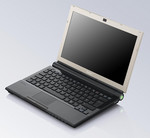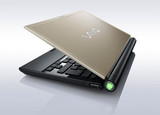Sony Vaio VGN-TZ18GN
Especificaciones de Portátil(es)

Price comparison
Promedio de 1 puntuaciones (de 1 análisis)
Análisis para el Sony Vaio VGN-TZ18GN
Origen: Hardware Zone
 EN→ES Archive.org version
EN→ES Archive.org versionCan we put a price to style? That's the question that confronted us while gathering our thoughts about the new Sony VAIO TZ series. There is much to admire about the design of the Sony TZ series, from its simple, minimalist chassis, pared down to the essentials so as to maintain its ultra portable form factor, yet flexible and not at all fragile. The unique and seamless integration of the battery into the spine and hinge of the notebook such that it really feels like a book, in both its relative weight and size. Its understated elegance is appropriate for the genial facades of the business world, where impressions are everything and of course, the Sony VAIO brand has established itself as a premium, expensive one that speaks of the finer things in life. For those who can afford it, the new Sony TZ series have both the pedigree and the style to impress your business partners and be the classy companion for the high flying executive. Seriously, this is one of the most well engineered notebooks we've come across and it really exudes oodles of class, style and quality.
4 von 5, Preis/Leistung zufriedenstellend, Leistung zufriedenstellend
Único Análisis, disponible online, largo, Fecha: 08/08/2007
Puntuación: Puntuación total: 80% precio: 70% rendimiento: 70%
Comentario
Intel Graphics Media Accelerator (GMA) 950: Intel Graphics Media Accelerator 950 es un chip de video integrado (incorporado) en Mobile Intel 945GM chipset. Es una versión con frecuencia más rápida del GMA 900.
Muchos juegos son difícilmente ejecutables con estos adaptadores gráficos o se ejecutan de manera muy lenta.
>> Más información puede ser encontrada en nuestra comparación de tarjetas gráficas moviles y la lista de benchmarks.
Intel Core 2 Duo: Este es el sucesor Core Duo y el Core Solo con un pipeline más largo y con una velocidad entre 5-20% sin mayor consumo de energía. Adicional al diseño de Core Duo existe un cuarto decodificador, una unidad SSE ampliada y una unidad lógica aritmética (ALU) adicional.
Sus características son: 2 núcleos (cores), una amplificación de comando de 64-bit EM64T y 2 o 4 MB L2 Cache y 291 millones de transistores, que son acabados en 65nm. Mas allá de esto, todos los tipos soportan técnicas "Execute Disable Bit", SSSE3 (SSE4), Enhanced Speedstep, LaGrande y la mayoría de técnicas de virtualizacion (VT) Vanderpool.
El Core 2 Duo para laptops es idéntico a los procesadores Core 2 Duo para desktops, pero los procesadores para notebooks trabajan con tensiones más bajas (0.95 a 1188 Volt) y un Frontside bus clock (1066 contra 667 MHz). El rendimiento de laptops cuena con una frecuencia de 20-25% más baja que PCs Desktop debido a una frecuencia más baja de Frontside bus y los discos duros más lentos.
U7600:
>> Más información puede ser encontrada en nuestra comparación de procesadores móviles.







